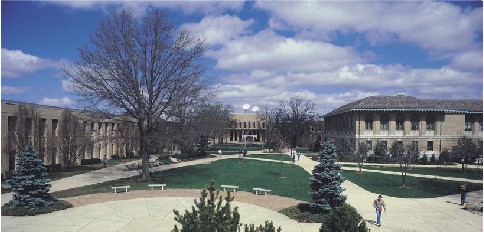

The campus mall at the University of Missouri-Rolla
As little as a decade ago, if you were asked to name universities that offered courses on electromagnetic compatibility (EMC), you would be hard-pressed to name more than a handful. Of course, you would have immediately responded by naming the University of Kentucky and the legendary Dr. Clayton Paul, but what others would you have named a decade ago?
These days, there are several respected universities that have joined the University of Kentucky as being well known for their EMC research and related courses. If you answered the above question today, you could rattle off at least ten universities. Following is a sampling of these worldwide institutions. Students who are considering obtaining an advanced degree may want to consider attending one of these institutions. Likewise, corporations who are seeking R&D assistance with their products as related to EMC may wish to contact one of these institutions. Bottom line is that EMC is a hot topic these days and while universities are catching on by adding the topic to their engineering course curriculum, corporations are also learning that experts residing at these institutions offer cost-effective assistance in furthering their product development and sales objectives.
Likewise, the Education and Student Activities Committee of the IEEE EMC Society is one of the hot committees these days. Just read the article on page 17 of this newsletter by Maqsood Mohd, Chairman of the Education and Student Activities Committee, to learn about the breadth of their activities scheduled for the 1999 IEEE International Symposium on EMC in Seattle this August. John Windell, Technical Papers Chairman of the Seattle Symposium, advised that there were 17 initial student paper abstracts submitted and 16 were accepted! John commented, “The response to the advertisement for the Student Paper Contest was much stronger than anticipated. We didn’t know what to expect, but we were hoping that the cash prize of $900, plus $2,100 for travel expenses to attend the symposium and present the paper, would be an incentive.” Further, John revealed that he is “extremely pleased with the caliber of the student papers submitted.” For reference, the student paper abstracts were circulated to the reviewers with no distinction made to identify them as student papers; they were evaluated along with all the other abstracts submitted. John advised that the selection of the Best Student Paper will be “a very difficult task.” This student paper contest is funded by the EMC Society Education and Student Activities Committee – just one more example of their many varied activities.
It is also interesting to note that there are several institutions, such as the Georgia Tech Research Institute (GTRI) and universities, such as Oklahoma University, Center for the Study of Wireless EMC, that are closely affiliated with industry on projects involving EMC studies. These institutions and universities will be profiled in a future article in this newsletter. Only those universities or institutions that regularly offer specific EMC courses are included in this article.
Let’s visit then some of the leading EMC universities worldwide….
Contact: Flavio Canavero, Ph.D, phone +39-011-5644060, e-mail: canavero@polito.it
Year Formal EMC Program Initiated: This institution holds the distinction of being the first to offer an EMC course in Italy, beginning in the 70s. The present EMC group was formed in 1986.
Primary Areas of Expertise: Analytical and numerical modeling of EMC problems, electromagnetic simulation of 3D structures, characterization of new materials for shielding, shielding theory, spectral theory of transmission lines, crosstalk on cables, effects of losses on interconnects, susceptibility of active IC’s, EMC measurements
EMC and Related Courses Offered: Introductory EMC, EMC Standards and Directives, EMC Design by Simulation, EMC related to Transmission Lines and Crosstalk, Emission and Immunity, EMC of Digital Systems, Shielding, ESD, PCB Design, Signal Integrity
Research Work: Theoretical and numerical modeling of EMC problems, and software development
Number of Students in Program: 60 at the undergraduate level, 50 at the master level, one at the Ph.D level per year
Number of Faculty: Three full professors, two associate professors, two assistant professors
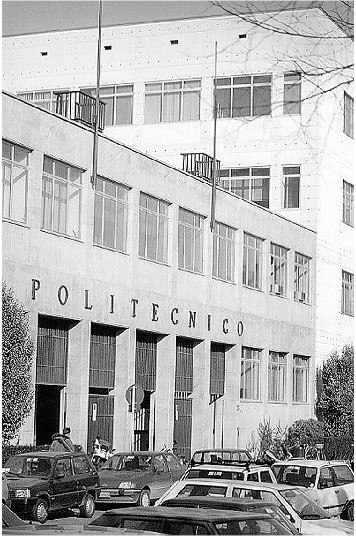
Central Building of University Politecnico di Torino.
Contact: Mrs. Maryan Marshman, phone +44-1904-432319, e-mail: acm4@york.ac.uk
Year Formal EMC Program Initiated: 1982
Primary Areas of Expertise: EMC measurements, design for EMC, EMC antennas, computational electromagnetics
EMC and Related Courses Offered: Fundamental and specialist EMC topics including design, measurement and management issues.
Research Work: EMC measurement techniques, EMC design techniques, EMC antenna design and computational electromagnetics. Through their associated company York EMC Services, they offer technical construction files and design consultancy.
Number of Students in Program: 40 at the master level (some 200 students took various EMC courses in 1998)
Number of Faculty: Five
Contact: James L. Drewniak, Ph.D, phone 573-341-4969, e-mail: drewniak@ece.umr.edu
Year Formal EMC Program Initiated: 1985
Primary Areas of Expertise: PCB layout and design, computational electromagnetic modeling, system EMC, shielding, power electronics, machines and drives, cabling.
EMC and Related Courses Offered: Introduction to EMC, High-Speed Digital Design, Antennas and Applications to EMC, Microwave Engineering, Advanced Electromagnetics I, Electromagnetic Waves II, Computational Electro- magnetics
Research Work: PCB design layout and evaluation for EMC, DC power bus design, CAD tool development, shielding enclosure analysis and design
Number of Students in Program: 18 graduate students and six undergraduate students
Number of Faculty: Four full-time and one visiting scholar
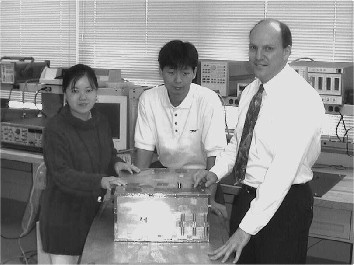
Professor Jim Drewniak with students Min Li (1998 President’s
Memorial Award recipient)
and Xiaoning Ye in the UMR EMC Laboratory.

An EMC course being presented in the video conference room at UMR
by Professor Todd Hubing.
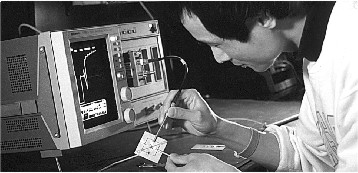
A student in the “High Speed Digital Design” course making
a
measurement in the UMR EMC Laboratory.
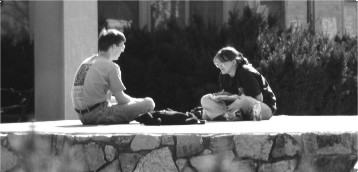
Students relaxing on the “hockey puck” at UMR.
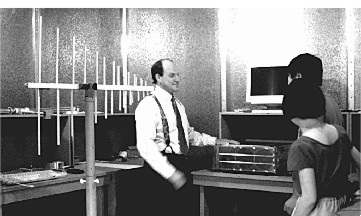
Jim Drewniak and students in the UMR RF shielded enclosure. UMR has
received several
donations from manufacturers of EMC related products, including
the shielded enclosure shown. These donations enable the University
to expand their EMC research and teaching capabilities.
Contact: Vichate Ungvichian, Ph.D, P.E., phone 561-338-1650, e-mail: ungvich@fau.edu
Year Formal EMC Program Initiated: 1987
Primary Areas of Expertise: EMC/RF measurement, PCB design, EM math modeling
EMC and Related Courses Offered: General EMC course where a PCB design project including an EMI emission measurement is mandatory.
Research Work: EMC compliance, redesign of PCB or grounding systems, crosstalk and ultra-high speed microstrip lines
Number of Students in Program: Two Ph.D students and three undergraduate students
Number of Faculty: Four full-time
Contact: Antonio Orlandi and Mauro Feliziani, e-mail: orlandi@ing.univaq.it
Year Formal EMC Program Initiated: 1990
Primary Areas of Expertise: Numerical techniques for EMC problems and EMC in power electronics
EMC and Related Courses Offered: Numerical Techniques to Approach EMC Problems, EMC in Biomedical Devices, Electromagnetic Pollution in Industry and High Frequency. (The EMC Laboratory of the Department of Electrical Engineering at the University of L’Aquila has based its practical lectures on the IEEE EMC Society Education Manual as well as the Experiments Manual and demonstrations which are presented annually at the IEEE International Symposia on EMC.)
Research Work: LEMP coupling, active and hybrid shieldings, EMC in power drive systems, PCB signal integrity analysis
Number of Students in Program: 122
Number of Faculty: Five

Classrooms' building of the School of Engineering

Library of the School of Engineering of the University of L'Aquila.
The School is 1000m above sea level on the hill of Roio.
Contact: Robert G. Olsen, Ph.D, phone 509-335-4950, e-mail: olsen@eecs.wsu.edu
Year Formal EMC Program Initiated: 1990
Primary Areas of Expertise: Power system EMC (EMI from high voltage systems, low frequency shielding)
EMC and Related Courses Offered: Basic Electromagnetic Theory, Distributed Parameter Systems, Electromagnetic Compatibility
Research Work: EMC of power systems and other electronic equipment (e.g. shielding of computer monitors from ELF magnetic fields)
Number of Students in Program: 8-12
Number of Faculty: Two
Contact: Robert Nelson, Ph.D, phone 701-231-7619, e-mail: r.m.nelson@ieee.org
Year Formal EMC Program Initiated: 1991
Primary Areas of Expertise: PCB design, ESD, numerical modeling and simulation of EMC effects, lightning effects, EMI in medical products, transmission lines and antennas
EMC and Related Courses Offered: Designing for EMC, Signal Integrity, and course presenting EMC Concepts in Communications Electronics, Power Electronics, Optical Signal Transmission, Digital Systems, Instrumentation, Microwave Engineering, Advanced Electromagnetics, Signal Processing
Research Work: Simulation and design of PCB layout (especially relating to signal integrity issues), EMC in medical electronics, modeling and simulation of radiation, ESD, and lightning.
Number of Students in Program: 40
Number of Faculty: Two
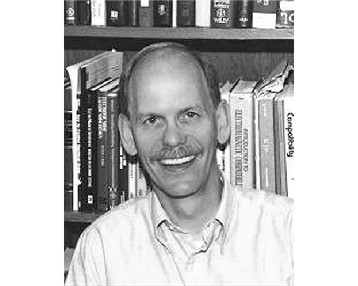
Bob Nelson of North Dakota State University and Secretary of the
EMC Society Education Committee.
Contact: M.D’Amore, Ph.D, e-mail: damore@elettrica.ing.uniroma1.it
Year Formal EMC Program Initiated: 1992
Primary Areas of Expertise: Shielding, characterization of composite materials, EMC in avionics, EM coupling
EMC and Related Courses Offered: Electromagnetic Compatibility for Industrial Engineers, Post-Graduated School in EMC
Research Work: Shielding, characterization of composite materials, EMC in avionics, coupling
Number of Students in Program: 50
Number of Faculty: Five
Contact: Zorica Pantic-Tanner, Ph.D, phone 415-338-7739, e-mail: zpt@sfsu.edu
Year Formal EMC Program Initiated: The program was started in 1993 with “seed money” provided by the Santa Clara Valley Chapter of the EMC Society
Primary Areas of Expertise: Electromagnetic field theory, applied electromagnetics, EMC
EMC and Related Courses Offered: EMC concepts are integrated throughout the EE curriculum in the following courses: Introduction to Engineering Electromagnetics, Communication Systems, Electromagnetic Waves and Engineering Electromagnetic Compatibility
Research Work: Time/frequency domain analysis of PCB crosstalk mechanisms, minimization of signal integrity waveform distortions, radiated field coupling into shielded enclosures with apertures, radiated field coupling onto unshielded and shielded cables
Number of Students in Program: 20 undergraduate students take the EMC related courses each year. Extensive student research projects include 10 undergraduate students and one MS student.
Number of Faculty: Two full-time and one part-time
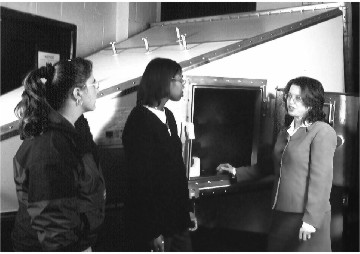
Dr. Pantic-Tanner (right) demonstrates the use of a GTEM cell as a
tool
for radiated emission measurements. Listening intently
are students Monica Harrison and Wesley Imani.
Contact: Clayton R. Paul, Ph.D, phone 912-752-2213, e-mail: paul_cr@mercer.edu
Year Formal EMC Program Initiated: There is no formal department; Dr. Paul’s department is the Electrical and Computer Engineering Department in the School of Engineering.
Primary Area of Expertise: Crosstalk
EMC and Related Courses Offered: Introduction to All Aspects of EMC for MSEE students.
Research Work: Not offered
Number of Students in Program: Two at the master level (35 students took the course in fall 1998)
Number of Faculty: One
Editor’s Note: Many thanks to Bob Nelson of North Dakota State University, and Secretary of the EMC Society Education Committee, for his assistance in soliciting the universities worldwide to participate in this article. (Those universities who responded to the survey were included in this article.) Thanks also to Maqsood Mohd, Chairman of the EMC Society Education and Student Activities Committee, for his guidance in the writing of this article and to John Howard for his input on the University Grant Program which follows this article.